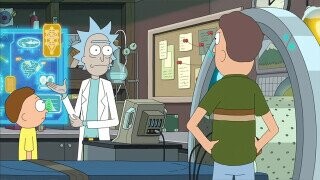Tonight’s ‘Rick and Morty’ Told Us What We Already Knew — In This Show, Death Is Merely A Math Problem

The funniest joke of Rick and Morty Season Seven thus far wasn’t actually spoken in Season Seven — it’s a slow burn from all the way back in Season One when Rick hilariously claimed, “I can’t cure death.”
That quote came from the Christmas episode “Anatomy Park,” which will celebrate its 10-year anniversary on Saturday while we once again gear up for the winter holidays with a reflective, vaguely spiritual Rick and Morty episode. A decade after Morty’s daring escape from the dying body of a homeless Santa Claus who housed Rick’s microscopic amusement park, the notion that death ever posed a serious threat to the plans of the smartest man in the Central Finite Curve is as quaint as capturing Bigfoot in a Pokeball. Tonight’s episode of Rick and Morty, “Mort: Ragnarick,” further reinforced a running theme throughout the last nine episodes of Rick and Morty in showing us that, a decade into the series, mortality has become just another law of nature that Rick takes about as seriously as the American legal system. As Rick says, “Break the laws, they shouldn’t exist anyway.”
Don't Miss
Immortal spoilers ahead for those who haven’t yet watched “Mort: Ragnarick,” in which death and the afterlife are about as consequential in Rick’s grand scheme of things as the Stephen Colbert trapped in his car battery.
“Mort: Ragnarick” confirms the existence of the afterlife — or, at least, some collective unconsciously constructed version of it — in the Rick and Morty universe, a breakthrough that is, naturally, more scientific than spiritual for our atheistic antihero. Rick quickly sets out to mine the para-dimension that is the Great Beyond for its unlimited energy potential by sending himself to Valhalla after baiting a captive Bigfoot into besting him in glorious battle. Naturally, Morty fucks the whole thing up, and Rick, Morty and Bigfoot spend most of the episode endlessly sending themselves back and forth between the afterlife and the waking world while the nefarious Pope enacts his own plans for post-mortal power mining.
The repetitive resurrections at the center of both “Mort: Ragnarick’s” plot and its greatest gags — like the increasingly creative ways the central trio gets vaporized by the supercharged Laser Pope — is only possible due to the off-screen fine-tuning of “Operation Phoenix,” Rick’s get-out-of-fatality-free contingency plan that was first introduced in an unsuccessful, prototypical state in Season Two’s “Big Trouble in Little Sanchez.” The consciousness-transferring clone scheme also played an important role in Season Four’s “Edge of Tomorty: Rick Die Rickpeat” and a lesser one in the Season Five finale “Rickmurai Jack,” though it was not nearly as neat in its execution as it was in tonight’s episode.
At this point in the canon’s continuity, “Operation Phoenix” has reached a hilarious level of efficiency, capable of creating dozens consciousness-transplanted clones in a matter of hours so long as it has an energy link to the next world. Compound this with Rick’s seeming ability to heal Morty’s self-inflicted gunshot wounds back in last month’s “Rickfending Your Mort” and his medical robot’s successful operation to bring both Rick and Jerry back to life (albeit with a bit of brain-scrambling) in “The Jerrick Trap,” and Season Seven seems to be the showrunner’s way of telling Rick and Morty fans that, from here on out, death is more of a speed bump than an end-of-the-road.
Of course, we’ve known for a couple seasons now that, through the countless on-screen deaths of many dimensions’ worth of Rick and Morty characters, mortality is relative — the apparent demise of Birdperson in the Season Two finale “The Wedding Squanchers” was one of the most shocking twists early in the series, but his seamless return to the world of the living raised serious questions about Rick’s relationship with the infinite back in “Rickternal Friendshine of the Spotless Mort.” For a show as complex as Rick and Morty, the finality of a traditional fatality is far less interesting than the search for meaning in a multiverse that has fewer and fewer limitations with each passing season.
However, there is still one way for a Rick and Morty character to permanently exit stage left — following the events of “Unmortricken,” Evil Morty, the show’s most compelling remaining question mark, has sole possession of the late Rick Prime’s Omega Device, meaning that the power to permanently erase someone from every possible existence is still lurking just outside the Central Finite Curve.
Pour one out for poor Slow Mobius.